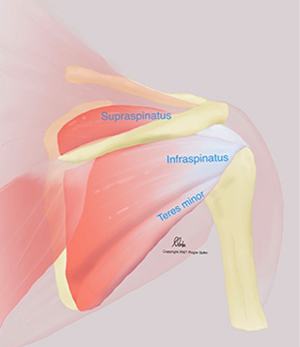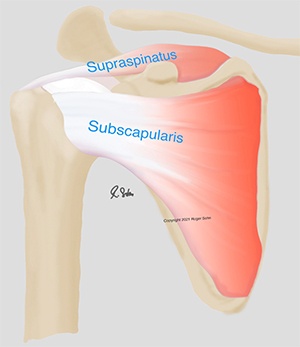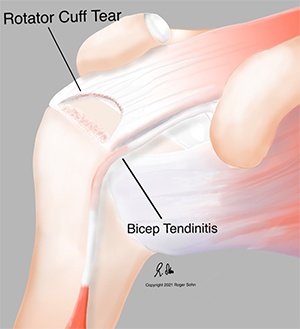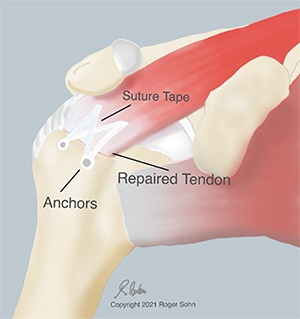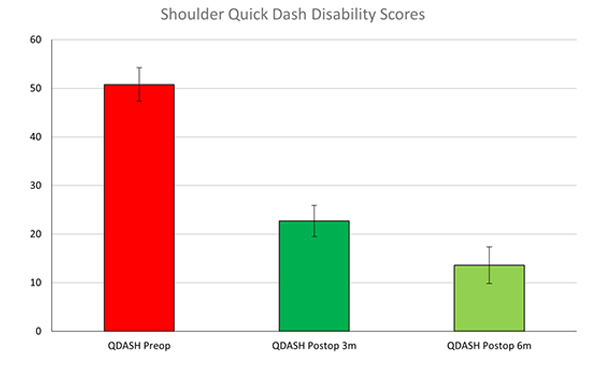
Rotator Cuff Repair Surgeon in San Juan Capistrano, Fountain Valley CA
Rotator cuff tears are commonly caused by acute injuries or degenerative changes that occur slowly with age or overuse. Dr. Sohn provides diagnosis and individualized nonoperative and operative treatments for the shoulder including rotator cuff repair in San Juan Capistrano, Fountain Valley CA. Dr. Sohn also provides the highest level of care during and after surgery. Contact Dr. Sohn’s office for an appointment today!
By Roger Sohn, MD
What is the Rotator Cuff and How Does it Tear?
The rotator cuff is a group of 4 muscles in the shoulder joint including the supraspinatus, infraspinatus, teres minor, and subscapularis. These muscles originate on the scapula and attach to the head of the humerus. The rotator cuff insertion forms a tendinous sleeve around the humerus, providing stability to the shoulder joint while enabling a wide range of movements.
Injury to the rotator cuff may happen due to attritional rubbing of the tendons on the “roof” or acromion of the shoulder. It may occur due to repeated use of the arm for overhead activities or while playing sports. A forceful injury such as trauma can cause one or more of these tendons to tear, a condition called a rotator cuff tear.
What is a Rotator Cuff Repair?
A rotator cuff repair is a surgery aimed at repairing an injured or torn rotator cuff. It is usually performed arthroscopically on an outpatient basis. Dr. Sohn is trained in arthroscopic techniques for repairing rotator cuffs in a minimally invasive way. The arthroscope and instruments can be placed through small incisions. Torn tendons can be reattached to the bone using suture anchors. This type of surgery is done on an outpatient basis under general anesthesia. Most moderate sized rotator cuff tears can be repaired in about 90 minutes.
When is Rotator Cuff Surgery Necessary?
Your doctor may suggest surgery to treat rotator cuff tears if you have tried other options with ongoing symptoms. Some people can adapt their activities to accommodate the abnormal mechanics and strength of the shoulder. However, in many patients, the pain and weakness cause ongoing loss of their quality of life. In these cases, surgery can be effective in restoring the shoulder’s function.
Preparing for the Surgery
Your doctor will assess your symptoms and take your medical history. Imaging tests such as an MRI may be ordered. Talk to your doctor about the medicines you are taking prior to the procedure and if you are allergic to any medicines or anesthesia. Arrange for someone to drive you home. Your doctor will have many specific instructions for you including the restrictions and physical therapy protocols.
Surgical Procedure
The surgery is performed under general anesthesia with a regional nerve block. It involves the following steps:
- Small incisions are made at the skin at various points around the shoulder joint.
- An arthroscope is inserted through the incision.
- Miniature surgical instruments are inserted to remove the damaged part of the tendon and injured surrounding tissue.
- The damaged ends of the tendon reattached to the bone using suture anchors. The anchors are made of a biocomposite material that becomes bone.
- Additional repairs may be done as needed (e.g. bicep tenodesis). (place link to bicep tenodesis page).
- The incision is closed and covered with a bandage.
What is the Post-Operative Care After a Rotator Cuff Repair?
Your shoulder will be placed in sling or immobilizer which is to be worn consistently for 2 weeks. After that, the sling should be worn when out in public up till the 6th week after surgery. You should expect to take prescription pain medicines to manage pain for the first 3-7 days after surgery. A cold therapy unit may be very useful in reducing postoperative pain. Physical therapy begins about 1-2 weeks after surgery. The most important restrictions are to avoid any active motion of the shoulder.
At first, the tendon is just held to the bone with sutures. It takes about 12 weeks for the tendon to grow roots into the bone. Thus, you should only work on stretching. The strengthening phase of physical therapy starts after 12 weeks. Most normal activities can be resumed after 6 months.
Risks and Complications
As with any surgery, there are associated risks and complications may occur. Those related to rotator cuff repair may include:
- Anesthetic complications
- Infection
- Nerve damage
- Stiffness
- Tendon re-tear
What are the Results after Rotator Cuff Repair?
We believe patients are the best judge of their results. We ask them to rate their disability using validated patient rated outcomes measures (PROMs) such as the Quick DASH. According to our most recent data analysis, our patients rated their disability at 51% prior to surgery. After 3 months, their disability dropped to 23%. By 6 months, their disability dropped to 13%. (read more about Rotator Cuff Repair).
Rotator Cuff Treatment Options


